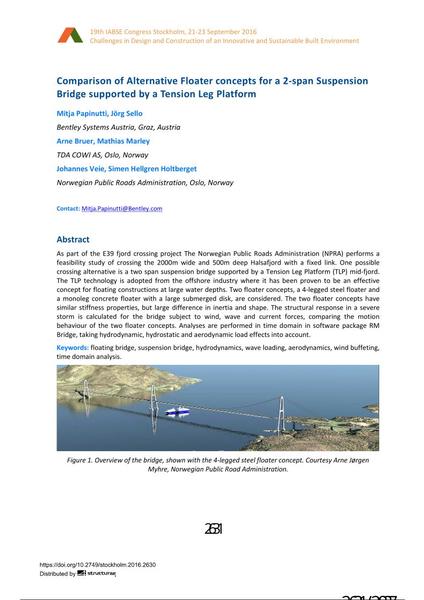Comparison of Alternative Floater concepts for a 2-span Suspension Bridge supported by a Tension Leg Platform

|
|
|||||||||||
Bibliographic Details
| Author(s): |
Mitja Papinutti
(Bentley Systems Austria, Graz, Austria)
Joerg Sello (Bentley Systems Austria, Graz, Austria) Arne Bruer (TDA COWI AS, Oslo, Norway) Mathias Marley (TDA COWI AS, Oslo, Norway) Johannes Veie (Norwegian Public Roads Administration, Oslo, Norway) Simen Hellgren Holtberget (Norwegian Public Roads Administration, Oslo, Norway) |
||||
|---|---|---|---|---|---|
| Medium: | conference paper | ||||
| Language(s): | English | ||||
| Conference: | IABSE Congress: Challenges in Design and Construction of an Innovative and Sustainable Built Environment, Stockholm, Sweden, 21-23 September 2016 | ||||
| Published in: | IABSE Congress Stockholm, 2016 | ||||
|
|||||
| Page(s): | 2631-2638 | ||||
| Total no. of pages: | 8 | ||||
| Year: | 2016 | ||||
| DOI: | 10.2749/stockholm.2016.2630 | ||||
| Abstract: |
As part of the E39 fjord crossing project The Norwegian Public Roads Administration (NPRA) performs a feasibility study of crossing the 2000m wide and 500m deep Halsafjord with a fixed link. One possible crossing alternative is a two span suspension bridge supported by a Tension Leg Platform (TLP) mid-fjord. The TLP technology is adopted from the offshore industry where it has been proven to be an effective concept for floating constructions at large water depths. Two floater concepts, a 4-legged steel floater and a monoleg concrete floater with a large submerged disk, are considered. The two floater concepts have similar stiffness properties, but large difference in inertia and shape. The structural response in a severe storm is calculated for the bridge subject to wind, wave and current forces, comparing the motion behaviour of the two floater concepts. Analyses are performed in time domain in software package RM Bridge, taking hydrodynamic, hydrostatic and aerodynamic load effects into account. |
||||
| Keywords: |
suspension bridge aerodynamics floating bridge wind buffeting time domain analysis hydrodynamics wave loading
|
||||


